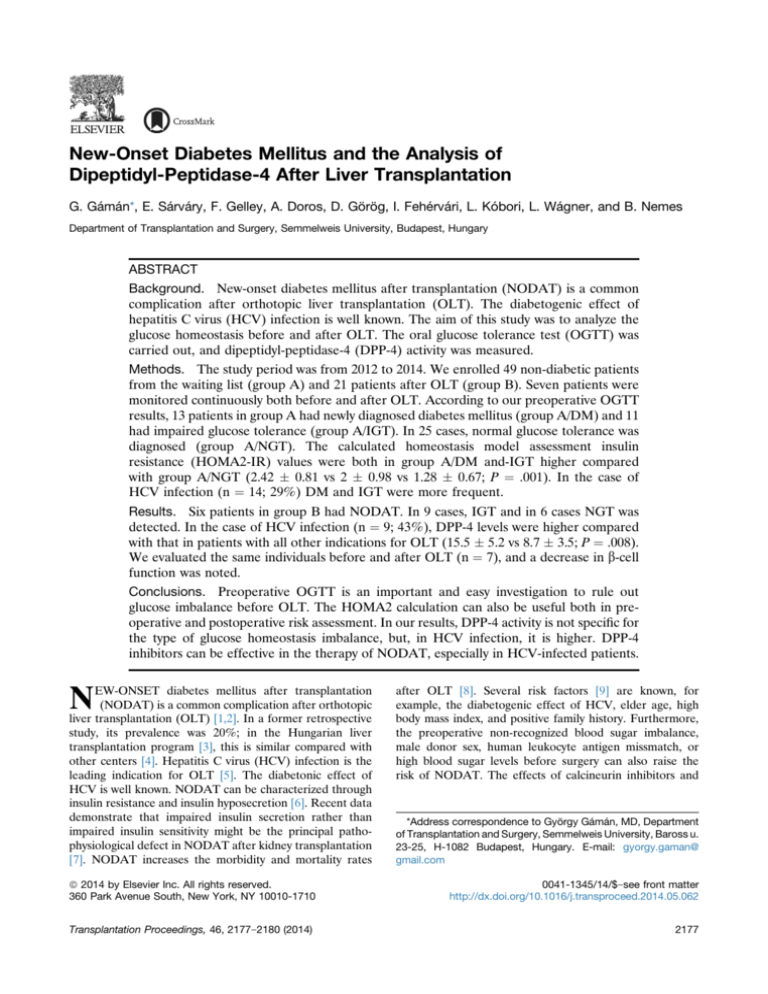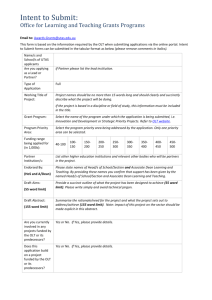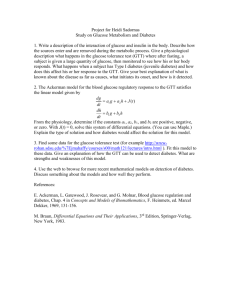
New-Onset Diabetes Mellitus and the Analysis of
Dipeptidyl-Peptidase-4 After Liver Transplantation
G. Gámán*, E. Sárváry, F. Gelley, A. Doros, D. Görög, I. Fehérvári, L. Kóbori, L. Wágner, and B. Nemes
Department of Transplantation and Surgery, Semmelweis University, Budapest, Hungary
ABSTRACT
Background. New-onset diabetes mellitus after transplantation (NODAT) is a common
complication after orthotopic liver transplantation (OLT). The diabetogenic effect of
hepatitis C virus (HCV) infection is well known. The aim of this study was to analyze the
glucose homeostasis before and after OLT. The oral glucose tolerance test (OGTT) was
carried out, and dipeptidyl-peptidase-4 (DPP-4) activity was measured.
Methods. The study period was from 2012 to 2014. We enrolled 49 non-diabetic patients
from the waiting list (group A) and 21 patients after OLT (group B). Seven patients were
monitored continuously both before and after OLT. According to our preoperative OGTT
results, 13 patients in group A had newly diagnosed diabetes mellitus (group A/DM) and 11
had impaired glucose tolerance (group A/IGT). In 25 cases, normal glucose tolerance was
diagnosed (group A/NGT). The calculated homeostasis model assessment insulin
resistance (HOMA2-IR) values were both in group A/DM and-IGT higher compared
with group A/NGT (2.42 0.81 vs 2 0.98 vs 1.28 0.67; P ¼ .001). In the case of
HCV infection (n ¼ 14; 29%) DM and IGT were more frequent.
Results. Six patients in group B had NODAT. In 9 cases, IGT and in 6 cases NGT was
detected. In the case of HCV infection (n ¼ 9; 43%), DPP-4 levels were higher compared
with that in patients with all other indications for OLT (15.5 5.2 vs 8.7 3.5; P ¼ .008).
We evaluated the same individuals before and after OLT (n ¼ 7), and a decrease in b-cell
function was noted.
Conclusions. Preoperative OGTT is an important and easy investigation to rule out
glucose imbalance before OLT. The HOMA2 calculation can also be useful both in preoperative and postoperative risk assessment. In our results, DPP-4 activity is not specific for
the type of glucose homeostasis imbalance, but, in HCV infection, it is higher. DPP-4
inhibitors can be effective in the therapy of NODAT, especially in HCV-infected patients.
N
EW-ONSET diabetes mellitus after transplantation
(NODAT) is a common complication after orthotopic
liver transplantation (OLT) [1,2]. In a former retrospective
study, its prevalence was 20%; in the Hungarian liver
transplantation program [3], this is similar compared with
other centers [4]. Hepatitis C virus (HCV) infection is the
leading indication for OLT [5]. The diabetonic effect of
HCV is well known. NODAT can be characterized through
insulin resistance and insulin hyposecretion [6]. Recent data
demonstrate that impaired insulin secretion rather than
impaired insulin sensitivity might be the principal pathophysiological defect in NODAT after kidney transplantation
[7]. NODAT increases the morbidity and mortality rates
after OLT [8]. Several risk factors [9] are known, for
example, the diabetogenic effect of HCV, elder age, high
body mass index, and positive family history. Furthermore,
the preoperative non-recognized blood sugar imbalance,
male donor sex, human leukocyte antigen missmatch, or
high blood sugar levels before surgery can also raise the
risk of NODAT. The effects of calcineurin inhibitors and
*Address correspondence to György Gámán, MD, Department
of Transplantation and Surgery, Semmelweis University, Baross u.
23-25, H-1082 Budapest, Hungary. E-mail: gyorgy.gaman@
gmail.com
ª 2014 by Elsevier Inc. All rights reserved.
360 Park Avenue South, New York, NY 10010-1710
0041-1345/14/$esee front matter
http://dx.doi.org/10.1016/j.transproceed.2014.05.062
Transplantation Proceedings, 46, 2177e2180 (2014)
2177
2178
GÁMÁN, SÁRVÁRY, GELLEY ET AL
Table 1. Preoperative Results (Group A; n [ 49)
Sex (male)
Body mass index
Age (years)
Triglyceride (mmol/L)
Cholesterol (mmol/L)
HDL (mmol/L)
LDL (mmol/L)
CRP (mg/L)
Uric acid (mmol/L)
Fasting glucose (mmol/L)
HbA1c (%)
HOMA2-IR
HCV infection (%)
Group A/DM (n ¼ 13)
Group A/IGT (n ¼ 11)
Group A/NGT (n ¼ 25)
P Value
23.1%
26 5.6
55.4 8.4
0.71 0.29
3 0.9
1.2 0.54
1.6 0.53
9 7.9
281 116
5.8 0.83
5.4 0.4
2.42 0.81
53.8
18.2%
24.3 4.3
52.6 9.1
0.67 0.24
41
1.6 0.56
2.2 0.88
5.4 5.4
310 122
4.6 0.51
5.3 0.4
2 0.98
45.5
23.1%
25.6 5.1
42.4 9.5
1.1 0.8
4.6 1.9
1.3 0.6
3.1 1.7
9.6 10
277 114
4.53 0.78
5.1 0.6
1.28 0.67
8.0
NS
NS
<.001
NS
NS
NS
.006
NS
NS
<.001
NS
.001
.005
Preoperatively evaluated parameters, significant at P < .05.
Abbreviations: DM, diabetes mellitus; IGT, impaired glucose tolerance; NGT, normal glucose tolerance; HDL, high-density lipoprotein; LDL, low-density lipoprotein;
HbA1C, hemoglobin A1c; CRP, C-reactive protein; HOMA2-IR, Homeostasis Model Assesment2-Insulin Resistance; HCV, hepatitis C virus.
anti-rejection steroid bolus treatment are also well known [9].
The aim of this study was to analyze the glucose homeostasis
of patients before and right after OLT. The purpose was to
carry out the oral glucose tolerance test (OGTT) [10] and to
measure and analyze dipeptidyl-peptidase-4 (DPP-4) activity.
DPP-4 enzyme inactivates the positive effect of inctein hormones on insulin secretion [11]. DPP-4 is actually an important target in anti-diabetic therapy, and, in HCV infection, its
expression is increased [12].
MATERIALS AND METHODS
The study period was between 2012 and 2014. On the waiting list,
49 non-diabetic patients were enrolled (group A) and 21 patients
after OLT were enrolled (group B). Seven patients were monitored continuously both before and after OLT. OGTT was performed. After at least a 12-hour fasting period during morning
hours (8:00 to 9:00 AM), blood samples were taken. Patients took a
75-g glucose solution. The second sample was taken after 120
minutes. The evaluated parameters were body mass index, blood
sugar, cholesterol, low-density lipoprotein (LDL), high-density
lipoprotein (HDL), C-reactive protein, insulin, and DPP-4 levels.
Insulin sensitivity and b-cell function were assessed with the use of
a HOMA2 calculator program [13]. The diagnostic criterium
(according to 120-minute blood sugar test) was the following:
NGT (<7.8 mmol/L), IGT (7.8e11.0 mmol/L), and DM
(>11.1 mmol/L) [10]. The determination of DPP-4 enzyme activity
was measured kinetically on an enzyme-linked immunoassay
reader (ANTHOS READER 2001, Anthos Labtec Instrument,
Salzburg/Austria/Europe) at 405 nm, 25 C, by monitoring the increase of absorbance caused by release of chromogenic (nitroanilide) substrate. The activity was expressed as U/L. Statistical
analysis was performed with the use of SPSS 15.0 software. A value
of P < .05 was considered to be significant.
RESULTS
Thirteen patients in group A (n ¼ 49)don the waiting
listdhad, by our OGTT, newly diagnosed DM (group
A/DM; 26.5%). In 11 cases, IGT was found (group A/IGT;
22.5%), whereas in NGT, 25 cases were found (group
A/NGT; 51%). Fasting glucose levels (mmol/L) were group
Table 2. Postoperative Results (Group B; n [ 21)
Sex (male)
Body mass index
Age (years)
Triglyceride (mmol/L)
Cholesterol (mmol/L)
HDL (mmol/L)
LDL (mmol/L)
CRP (mg/L)
Fasting glucose (mmol/L)
HBA1c (%)
HOMA2-IR
HCV infection (%)
Fasting DPP-4 activity (U/L)
Group B/NODAT (n ¼ 6)
Group B/IGT (n ¼ 9)
Group B/NGT (n ¼ 6)
P Value
50%
25.5 1.9
49 11.9
2 0.63
4.3 1.1
1.31 0.53
2.3 1.1
3.1 1.45
8.4 6.5
6.7 2.5
1.56 0.35
50
11.54 6
78%
27.1 3.9
50 10.6
1.7 0.51
4.8 1.7
1.35 0.4
3.1 1.5
2.36 2.61
5.6 0.46
5.5 0.8
1.46 0.56
33
11 4.2
50%
22.45 2.8
51.5 9.5
1.6 0.53
4.6 1.3
1.45 0.6
2.6 0.5
3.5 3.5
4.8 0.45
4.8 0.6
0.67 0.16
50
12.5 6.9
NS
NS
NS
NS
NS
NS
NS
NS
NS
NS
.005
NS
NS
Postoperatively evaluated parameters, significant at P < .05.
Abbreviations: NODAT, new-onset diabetes mellitus after transplantation; IGT, impaired glucose tolerance; NGT, normal glucose tolerance; HDL, high-density lipoprotein; LDL, low-density lipoprotein; HbA1C, hemoglobin A1c; CRP, C-reactive protein; HOMA2-IR, Homeostasis Model Assesment2-Insulin Resistance; HCV,
hepatitis C virus; DPP-4, dipeptidyl-peptidase-4.
NEW-ONSET DM AND ANALYSIS OF DPP-4 AFTER LIVER TRANSPLANT
Fig 1. Results of DPP-4 activity after liver transplantation (group
B, n ¼ 21) Dipeptidyl-peptidase-4 activity (U/L): NGT ¼ 12.5 6.9; IGT ¼ 11 4.2; DM ¼ 11.54 6 (P ¼ NS); HCV vs nonHCV (15.5 5.2 vs 8.7 3.5; P ¼ .008). NGT, normal glucose
tolerance; IGT, impaired glucose tolerance; DM, diabetes mellitus; control, healthy control population (n ¼ 14; DPP-4 activity
U/L: 10.9 2.1).
A/DM: 5.8 0.83; group A/IGT: 4.6 0.51; and group
A/NGT: 4.53 0.78 (P < .0001). The 67% of the patients in
group A/DM and group IGT had a fasting blood sugar level
in the normal range (3.9e5.8 mmol/L). The mean values of
the calculated HOMA2-IR levels were group A/DM: 2.42 0.81 vs group A/IGT: 2 0.98 vs group A/NGT: 1.28 0.67;
P ¼ .001. The prevalence of HCV in group A/DM and in
group A/IGT were higher compared with group A/NGT
(P ¼ .005). PreOLT parameters are shown on Table 1.
Regarding the postoperative results (Table 2): 6 patients of
group B had NODAT (group B/NODAT; 28.6%), 9 had
IGT (group B/IGT; 42.8%), and in 6 cases, NGT was
diagnosed (group B/NGT). Fasting DPP-4 activities were
not different in the postoperative groups, but in the case of
HCV infection (n ¼ 9), values were higher compared with
that in patients with all other indications for OLT (15.5 5.2 vs 8.7 3.5; P ¼ .008). DPP-4 activity is shown in Fig 1.
Patients followed both before and after OLT (n ¼ 7), had in
4 cases NGT and in 3 cases IGT before transplantation.
Postoperative results were IGT: n ¼ 4 and NODAT: n ¼ 3.
Fig 2 shows the individual changes of insulin sensitivity and
reflects to the b-cell function of patients before and after
OLT. These patients were characterized as having a
decrease in b-cell function.
DISCUSSION
Diagnosis and therapy of NODAT is an important challange
after liver transplantation. Preoperative OGTT is effective,
because non-recognized glucose homeostasis imbalance is a
high risk factor for development of NODAT. Diabetes
2179
Fig 2. Individual changes of insulin sensitivity and b-cell function
before and after OLT. Individul changes of insulin sensitivity
(HOMA2S%) and b-cell function (HOMA2B%) before and after
OLT are shown. X axis: patients monitored both before and after
transplantation (n ¼ 7; A to G). Y axis: percent scale (%). Points
connected with dotted lines show b-cell function (gray line, preoperative values; black line, postoperatvie values). Points connected
with simple lines refer to insulin sensitivity of the patients (gray line,
preoperative values; black line, postoperatvie values).
mellitus is highly assocciated with HCV. Further messurements of DDP-4 activity are needed, but according to our
results, DPP-4 activity is more strongly associated with HCV
infection than with the type of glucose homeostasis imbalance. According to the HOMA2 and DPP-4 activity results,
the use of DPP-4 inhibitors in HCV-infected, posteliver
transplant patients can be effective in the therapy of
NODAT.
REFERENCES
[1] Rakel A, Karelis AD. New-onset diabetes after transplantation: risk factors and clinical impact. Diabetes Metab
2011;37:1e14.
[2] Mansell H, Worobetz LJ, Sylwestrowicz T, et al.
A retrospective study of the Framingham cardiovascular risk scores
in a liver transplant population. Transplant Proc 2013;45:308e14.
[3] Gelley F, Zadori G, Firneisz G, et al. Relationship between
hepatitis C virus recurrence and de novo diabetes after liver
transplantation: the Hungarian experience. Transplant Proc
2011;43:1281e2.
[4] Chen T, Jia HY, Li JW, et al. New onset diabetes mellitus
after liver transplantation and hepatitis C virus infection: metaanalysis of clinical studies. Transplant Int 2009;22:408e15.
[5] Nemes B, Gelley F, Piros L, et al. The impact of Milan
criteria on liver transplantation for hepatocellular carcinoma: first
15 years’ experience of the Hungarian Liver Transplant Program.
Transplant Proc 2011;43:1272e4.
[6] Ravindran V, Baboolal K, Moore R. Post transplant diabetes
mellitus after renal transplantation: the emerging clinical challenge.
Yonsei Med J 2004;45:1059e64.
[7] Haidinger M, Werzowa J, Hecking M, et al. Efficacy and
safety of vildagliptin in new-onset diabetes after kidney
transplantation-a randomized, double-blind, placebo-controlled
trial. Am J Transplant 2014;14:115e23.
2180
[8] Uchida J, Iwai T, Machida Y, et al. Insulin resistance and
insulin secretion in renal transplant recipients with hepatitis C.
Transplant Proc 2013;45:1540e3.
[9] Yates CJ, Fourlanos S, Hjelmesaeth J, et al. New-onset diabetes after kidney transplantation-changes and challenges. Am J
Transplant 2012;12:820e8.
[10] American Diabetes Association. Diagnosis and classification
of diabetes mellitus. Diabetes Care 2012;35(Suppl 1):S64e71.
GÁMÁN, SÁRVÁRY, GELLEY ET AL
[11] Holst JJ, Deacon CF. Is there a place for incretin therapies in
obesity and prediabetes? Trends Endocrinol Metab 2013;24:145e52.
[12] Itou M, Kawaguchi T, Taniguchi E, et al. Altered expression
of glucagon-like peptide-1 and dipeptidyl peptidase IV in patients
with HCV-related glucose intolerance. J Gastroenterol Hepatol
2008;23:244e51.
[13] HOMA Calculator of University of Oxford. Available from:
http://www.dtu.ox.ac.uk/homacalculator/.






